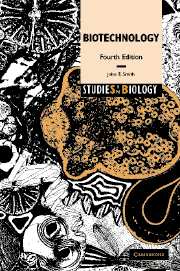Book contents
- Frontmatter
- Contents
- Preface
- 1 The nature of biotechnology
- 2 Substrates for biotechnology
- 3 Genetics and biotechnology
- 4 Bioprocess/fermentation technology
- 5 Enzyme technology
- 6 Biological fuel generation
- 7 Single cell protein (SCP)
- 8 Biotechnology and medicine
- 9 Environmental biotechnology
- 10 Biotechnology in the agricultural and forestry industries
- 11 Food and beverage biotechnology
- 12 Protection of biotechnological inventions
- 13 Safety in biotechnology
- 14 Public perception of biotechnology: genetic engineering – safety, social, moral and ethical considerations
- 15 Looking to the future
- Glossary
- Further reading
- Index
6 - Biological fuel generation
Published online by Cambridge University Press: 05 June 2012
- Frontmatter
- Contents
- Preface
- 1 The nature of biotechnology
- 2 Substrates for biotechnology
- 3 Genetics and biotechnology
- 4 Bioprocess/fermentation technology
- 5 Enzyme technology
- 6 Biological fuel generation
- 7 Single cell protein (SCP)
- 8 Biotechnology and medicine
- 9 Environmental biotechnology
- 10 Biotechnology in the agricultural and forestry industries
- 11 Food and beverage biotechnology
- 12 Protection of biotechnological inventions
- 13 Safety in biotechnology
- 14 Public perception of biotechnology: genetic engineering – safety, social, moral and ethical considerations
- 15 Looking to the future
- Glossary
- Further reading
- Index
Summary
As world populations continue to increase, there is also a growing per capita demand for energy. Coupled to this are the international commitments to reduce carbon dioxide emissions that were agreed at the Kyoto Conference.
Photosynthesis: the ultimate energy resource
The total economically recoverable world reserves of the three main fossil fuels, namely coal, natural gas and oil – applying current technology and assuming continued consumption of present-day rates – are, respectively, less than 1000 years, 35 years and 16 years. Modern industry is almost totally dependent on these limited supplies. Approximately 93% of fossil fuel consumed throughout the world is for energy production, with only 7% being used by industry for the production of solvents, plastics and a host of other organic chemicals.
The continual depletion of global fossil-fuel energy has generated an ever-increasing need to seek out alternative sources of energy. These have so far included: the harnessing of hydro-, tidal, wave and wind power; the capture of solar and geothermal energy supplies; and the much misunderstood, but most significant – nuclear power. With all of these systems there is as yet no definitive answer on both the economic and energetic outlay necessary for successful operation. However, it cannot be doubted that fossil fuels will disappear completely in the not too distant future.
- Type
- Chapter
- Information
- Biotechnology , pp. 102 - 117Publisher: Cambridge University PressPrint publication year: 2004



